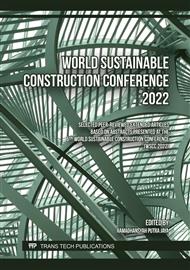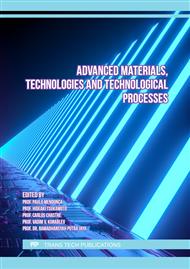[1]
A. Haryanti, N. Norsamsi, P. S. F. Sholiha, and N. P. Putri, "Study on the utilization of palm oil solid waste," Konversi, vol. 3, no. 2, pp.57-66, 2014.
Google Scholar
[2]
M. N. Huda, M. Z. B. Jumat, and A. S. Islam, "Flexural performance of reinforced oil palm shell & palm oil clinker concrete (PSCC) beam," Construction and Building Materials, vol. 127, pp.18-25, 2016.
DOI: 10.1016/j.conbuildmat.2016.09.106
Google Scholar
[3]
S. P. Yap, U. J. Alengaram, K. H. Mo, and M. Z. Jumaat, "High strength oil palm shell concrete beams reinforced with steel fibres," Materiales de Construcción, vol. 67, no. 328, p.142, 2017.
DOI: 10.3989/mc.2017.11616
Google Scholar
[4]
Y. B. Traore, A. Messan, K. Hannawi, J. Gérard, W. Prince-Agbodjan, and F. Tsobnang, "Experimental investigations on the physical and mechanical properties of a lightweight concrete using oil palm shell as coarse aggregate," Journal of Materials Science and Engineering, vol. 7, no. 5-6, pp.157-168, 2017.
DOI: 10.17265/2161-6213/2017.5-6.005
Google Scholar
[5]
J. K. Selvan and N. Selva, "Experimental Investigation on Concrete Using Oil Palm Shell," Science and Technology of Advanced Materials, vol. 4, pp.1-19, 2018.
Google Scholar
[6]
H. Gurdián, E. García-Alcocel, F. Baeza-Brotons, P. Garcés, and E. Zornoza, "Corrosion Behavior of Steel Reinforcement in Concrete with Recycled Aggregates, Fly Ash and Spent Cracking Catalyst," Materials, vol. 7, no. 4, pp.3176-3197, 2014.
DOI: 10.3390/ma7043176
Google Scholar
[7]
A. Landa-Sánchez, J. Bosch, M. A. Baltazar-Zamora, R. Croche, L. Landa-Ruiz, G. Santiago-Hurtado, V. M. Moreno-Landeros, J. Olguín-Coca, L. López-Léon, J. M. Bastidas, J. M. Mendoza-Rangel, J. Ress, and D. M. Bastidas, "Corrosion Behavior of Steel-Reinforced Green Concrete Containing Recycled Coarse Aggregate Additions in Sulfate Media," Materials, vol. 13, no. 19, p.4345, 2020.
DOI: 10.3390/ma13194345
Google Scholar
[8]
Y. Zhao, J. Dong, Y. Wu, H. Wang, X. Li, and Q. Xu, "Steel corrosion and corrosion-induced cracking in recycled aggregate concrete," Corrosion Science, vol. 85, pp.241-250, 2014.
DOI: 10.1016/j.corsci.2014.04.028
Google Scholar
[9]
A. Zaki, O. Putri, S. Yadi, and E. Rommel, "Mechanical Behavior of Corroded Steel in Lightweight Concrete: A Review," IOP Conference Series: Earth and Environmental Science, vol. 832, p.012015, 2021.
DOI: 10.1088/1755-1315/832/1/012015
Google Scholar
[10]
S. Daneshmand and O. Saadatian, "Influence of oil palm shell on workability and compressive strength of high strength concrete," Annals of the Faculty of Engineering Hunedoara, vol. 9, no. 2, p.51, 2011.
Google Scholar
[11]
A. Pratama, A. Ameridya, R. A. Pudi, and S. F. Absyar, "Waste Mask in Pandemic Era: Crime Increasing or Decreasing?," Journal of Green Growth and Environmental Management, vol. 10, no. 1, pp.51-58, 2021.
DOI: 10.21009/jgg.101.05
Google Scholar
[12]
Y. Zhang, N. Li, G. Lv, and Z. Chen, "Quantification of fatigue damage at dry–wet cycles of polymer fiber cement mortar," Materials Letters, vol. 257, p.126754, 2019.
DOI: 10.1016/j.matlet.2019.126754
Google Scholar
[13]
R. Madandoust, M. Kazemi, P. K. Talebi, and J. de Brito, "Effect of the curing type on the mechanical properties of lightweight concrete with polypropylene and steel fibres," Construction and Building Materials, vol. 223, pp.1038-1052, 2019.
DOI: 10.1016/j.conbuildmat.2019.08.006
Google Scholar
[14]
S. A. Mangi, M. H. W. Ibrahim, N. Jamaluddin, M. F. Arshad, and S. Shahidan, "Performances of concrete containing coal bottom ash with different fineness as a supplementary cementitious material exposed to seawater," Engineering Science and Technology, an International Journal, vol. 22, no. 3, pp.929-938, 2019.
DOI: 10.1016/j.jestch.2019.01.011
Google Scholar
[15]
R. Rodrigues, S. Gaboreau, J. Gance, I. Ignatiadis, and S. Betelu, "Reinforced concrete structures: A review of corrosion mechanisms and advances in electrical methods for corrosion monitoring," Construction and Building Materials, vol. 269, p.121240, 2021.
DOI: 10.1016/j.conbuildmat.2020.121240
Google Scholar
[16]
B. Dong, G. Fang, Y. Liu, P. Dong, J. Zhang, F. Xing, and S. Hong, "Monitoring reinforcement corrosion and corrosion-induced cracking by X-ray microcomputed tomography method," Cement and Concrete Research, vol. 100, pp.311-321, 2017.
DOI: 10.1016/j.cemconres.2017.07.009
Google Scholar
[17]
V. Maruthapandian, V. Saraswathy, and S. Muralidharan, "Development of solid state embeddable reference electrode for corrosion monitoring of steel in reinforced concrete structures," Cement and Concrete Composites, vol. 74, pp.100-108, 2016.
DOI: 10.1016/j.cemconcomp.2016.09.001
Google Scholar
[18]
W. Shen, Y. Liu, B. Yan, J. Wang, P. He, C. Zhou, X. Huo, W. Zhang, G. Xu, and Q. Ding, "Cement industry of China: driving force, environment impact and sustainable development," Renewable and Sustainable Energy Reviews, vol. 75, pp.618-628, 2017.
DOI: 10.1016/j.rser.2016.11.033
Google Scholar
[19]
Y. Wang, X. Gong, and L. Wu, "Prediction model of chloride diffusion in concrete considering the coupling effects of coarse aggregate and steel reinforcement exposed to marine tidal environment," Construction and Building Materials, vol. 216, pp.40-57, 2019.
DOI: 10.1016/j.conbuildmat.2019.04.221
Google Scholar
[20]
A. Zaki and Z. Ibrahim, "Secondary AE Analysis of Pre-corroded Concrete Beam," in Lecture Notes in Civil Engineering, 2023, vol. 225, pp.243-255.
DOI: 10.1007/978-981-16-9348-9_22
Google Scholar
[21]
A. Zaki and Z. Ibrahim, "Corrosion Assessment of Pre-corrosion Concrete Specimens using Acoustic Emission Technique," Journal of Engineering and Technological Sciences, vol. 53, no. 2, p.210111, 2021.
DOI: 10.5614/j.eng.technol.sci.2021.53.2.11
Google Scholar
[22]
P. Matar and G.-P. Zéhil, "Effects of polypropylene fibers on the physical and mechanical properties of recycled aggregate concrete," Journal of Wuhan University of Technology-Mater. Sci. Ed., vol. 34, no. 6, pp.1327-1344, 2019.
DOI: 10.1007/s11595-019-2196-6
Google Scholar
[23]
M. Usman Rashid, "Experimental investigation on durability characteristics of steel and polypropylene fiber reinforced concrete exposed to natural weathering action," Construction and Building Materials, vol. 250, p.118910, 2020.
DOI: 10.1016/j.conbuildmat.2020.118910
Google Scholar
[24]
A. Arista and R. Prasetyo, "Identification of the Causes of Cracks in the Platform Module (H-Beam) using the NDT (Non Destructive Test) Method at PT Multi Gunung Mas Batam," Journal of Industrial Systems Engineering, vol. 4, no. 1, pp.40-49, 2018.
Google Scholar
[25]
ASTM C33M-18 Standard specification for concrete aggregates,, ASTM, West Conshohocken, PA, USA, 2018.
Google Scholar
[26]
SK SNI 2834-2000 The procedure for making a normal concrete mix plan BSN, Indonesia, 2000.
Google Scholar
[27]
SNI 1972-2008 Slump Test Method, BSN, Indonesia, 2008.
Google Scholar
[28]
ASTM G1-03 Standard Practice for Preparing, Cleaning, and Evaluating Corrosion Test Specimens, ASTM, West Conshohocken, PA, USA, 2017.
Google Scholar
[29]
ASTM G31-72 Standard practice for laboratory immersion corrosion testing of metals, ASTM, West Conshohocken, PA, USA, 2004.
Google Scholar
[30]
SNI 03-1973-2008 Test Method for Fill Weight, Mixed Production Volume and Air Content of Concrete, BSN, Indonesia, 2008.
Google Scholar
[31]
M. L. Fadillah, I. Ismeddiyanto, and M. Olivia, "Density, Slump Value, and Compressive Strength of OPC and OPC POFA Concrete with Mixture of Peat Water Exposed in Peat Environment," Riau University, Riau, 2017.
Google Scholar
[32]
SNI 4431-2011 How to Test Normal Concrete Flexural Strength with Two Load Points, BSN, Indonesia, 2011.
Google Scholar
[33]
SNI 4154-2014 Method of testing the flexural strength of concrete (using a simple beam with a concentrated load in the middle of the span), BSN, Indonesia, 2014.
Google Scholar
[34]
H. Layssi, P. Ghods, A. R. Alizadeh, and M. Salehi, "Electrical resistivity of concrete," Concrete International, vol. 37, no. 5, pp.41-46, 2015.
Google Scholar
[35]
AASHTO TP-95 Standard Test Method for Surface Resistivity of Concrete's Ability to Resist Chloride Ion Penetration, AASHTO, 2011.
Google Scholar
[36]
A. Zaki, H. K. Chai, D. G. Aggelis, and N. Alver, "Non-destructive evaluation for corrosion monitoring in concrete: A review and capability of acoustic emission technique," Sensors, vol. 15, no. 8, pp.19069-19101, 2015.
DOI: 10.3390/s150819069
Google Scholar
[37]
N. J. Carino, "The impact-echo method: an overview," in Proceedings of the 2001 Structures Congress & Exposition, 2001: Citeseer, pp.21-23.
Google Scholar
[38]
S. A. P. Rosyidi, K. Nayan, and M. R. Taha, "Measurement of subgrade stiffness using the SASW method," in Malaysian Geotechnical Conference, Petaling Jaya, Kuala Lumpur, 2004, pp.14-16.
Google Scholar
[39]
S. A. P. Rosyidi and N. I. Md. Yusoff, "Wavelet-Spectrogram Analysis of Surface Wave Technique for In Situ Pavement Stiffness Measurement," Journal of Materials in Civil Engineering, vol. 30, no. 11, p.04018304, 2018.
DOI: 10.1061/(asce)mt.1943-5533.0002504
Google Scholar
[40]
F. Alrshoudi, H. Mohammadhosseini, M. Md. Tahir, R. Alyousef, H. Alghamdi, Y. R. Alharbi, and A. Alsaif, "Sustainable Use of Waste Polypropylene Fibers and Palm Oil Fuel Ash in the Production of Novel Prepacked Aggregate Fiber-Reinforced Concrete," Sustainability, vol. 12, no. 12, p.4871, 2020.
DOI: 10.3390/su12124871
Google Scholar
[41]
M. Saberian, J. Li, S. Kilmartin-Lynch, and M. Boroujeni, "Repurposing of COVID-19 single-use face masks for pavements base/subbase," Science of the Total Environment, vol. 769, p.145527, 2021.
DOI: 10.1016/j.scitotenv.2021.145527
Google Scholar
[42]
P. G. Azarsa, Rishi, "Electrical resistivity of concrete for durability evaluation: a review," Advances in Materials Science and Engineering, vol. 2017, 2017.
Google Scholar
[43]
D. A. Nugraha, "Effect of Partial Replacement of Concrete Coarse Aggregate with Oil Palm Shells Using the NDT Method," Universitas Muhammadiyah Yogyakarta, Yogyakarta, 2021.
Google Scholar
[44]
S. A. P. Rosyidi, M. R. Taha, and N. I. M. Yusoff, SASW Technology for Road Pavement Evaluation. LP3M-UMY, 2017.
Google Scholar
[45]
M. Nili and V. Afroughsabet, "The long-term compressive strength and durability properties of silica fume fiber-reinforced concrete," Materials Science and Engineering A, vol. 531, pp.107-111, 2012.
DOI: 10.1016/j.msea.2011.10.042
Google Scholar
[46]
V. Afroughsabet and T. Ozbakkaloglu, "Mechanical and durability properties of high-strength concrete containing steel and polypropylene fibers," Construction and Building Materials, vol. 94, pp.73-82, 2015.
DOI: 10.1016/j.conbuildmat.2015.06.051
Google Scholar
[47]
T. B. Aulia, "Effects of polypropylene fibers on the properties of high-strength concretes," Institutes for Massivbau and Baustoffechnologi, University Leipzig, Lacer, vol. 7, 2002.
Google Scholar



